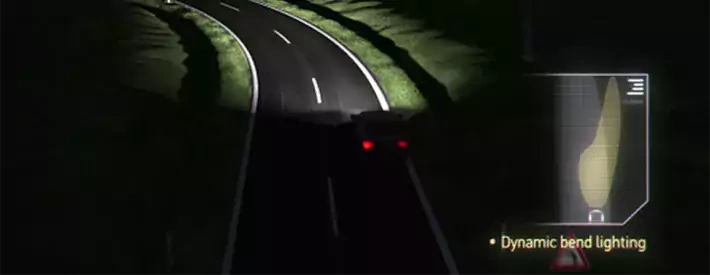How it works: Adaptive lighting

Adaptive lighting might sound ultra-modern, but one of the first of these systems was actually introduced way back in 2003. Described as the dynamic bend lighting function, it involved a light that moved with the steering angle, almost doubling the range of visibility.
In recent years, several companies have been involved in the development of advanced lighting systems. The information provided primarily to Hella’s offering, but other systems are similar.
Hella’s Adaptive Frontlight System (AFS) was a development of the earlier bend lighting system. It uses both the steering angle and the vehicle speed to set the best lighting for the current conditions. After all, traditional low beam can only ever be a compromise between various different light distributions.
Hella’s adaptive cut-off line (aCOL) feature uses information from the vehicle’s surroundings to determine the optimum light distribution. A camera detects oncoming traffic and cars ahead, for example, and a stepper motor turns the cylinder of the VarioX module to the required position within milliseconds. This means that the light cone will always end directly in front of oncoming traffic, or just behind the car ahead.
With the aCOL system, it’s therefore possible to drive with the high beam on at all times. When the camera detects other traffic on the road, the distribution of light from the high beam is adjusted to mask specific areas.
The latest matrix LED system also allows the driver to use high beam without running the risk of dazzling oncoming traffic or any preceding vehicles. In this case, LEDs with individual electronic control are turned up or dimmed down as required.
This technology makes it possible to open several tunnels at the same time. While these are “hidden”, the high beam continues to illuminate all areas between the vehicles and to the left and right at full power.
What adaptive lighting can do
- Town light - Activated at speeds below 55kph, town light features a horizontal cut-off line to minimise glare for other people on the road. Wide light distribution also makes it easier to detect pedestrians at the side of the road.
- Country light - Activated between speeds of 55 and 100kph, country light is similar to conventional low beam light distribution. The VarioX module generates an asymmetrical light distribution pattern to minimise glare for oncoming drivers. The cut-off line is raised so that the left edge of the road is better illuminated, providing greater coverage.
- Motorway light - Activated at speeds above 100kph, this light distribution range is designed for wide curve radii at high speeds.
- High beam - Adaptive high beam works like a conventional high beam, but does not require the driver to act to avoid exposing oncoming drivers to excessive glare.
- Dynamic bend lighting - This mode swivels the headlamps by up to 15 to allow optimised illumination of the bend ahead.
- Adverse weather light - This option creates a wider dispersion of the light to improve visibility in rain, fog or snow. This feature also reduces long-range illumination to minimise reflective glare affecting the driver’s own vehicle.




